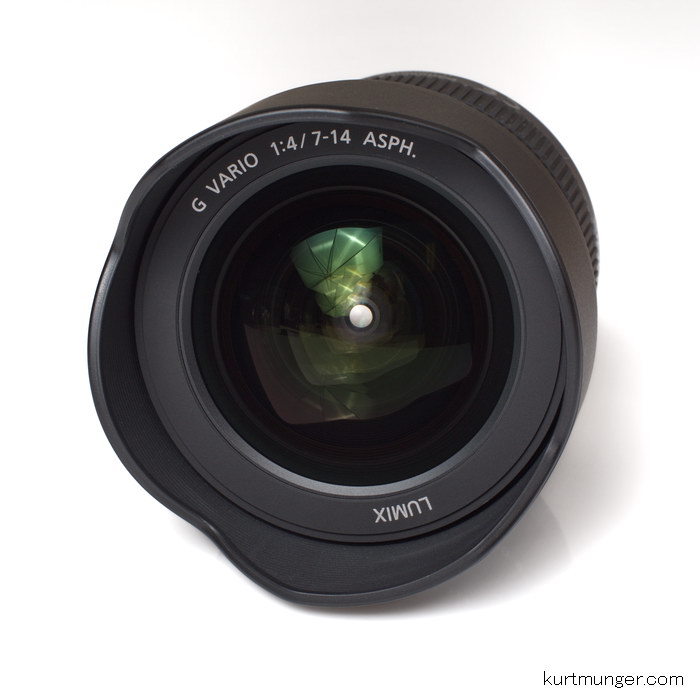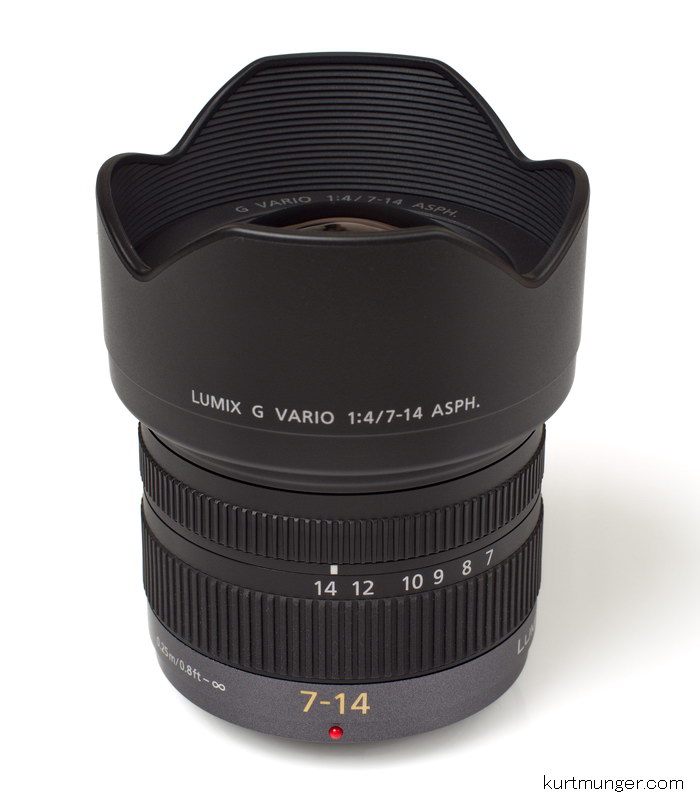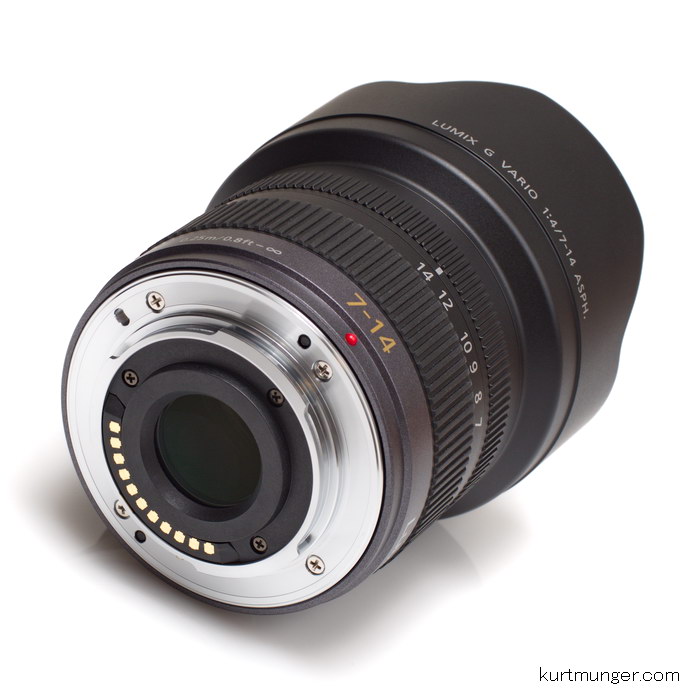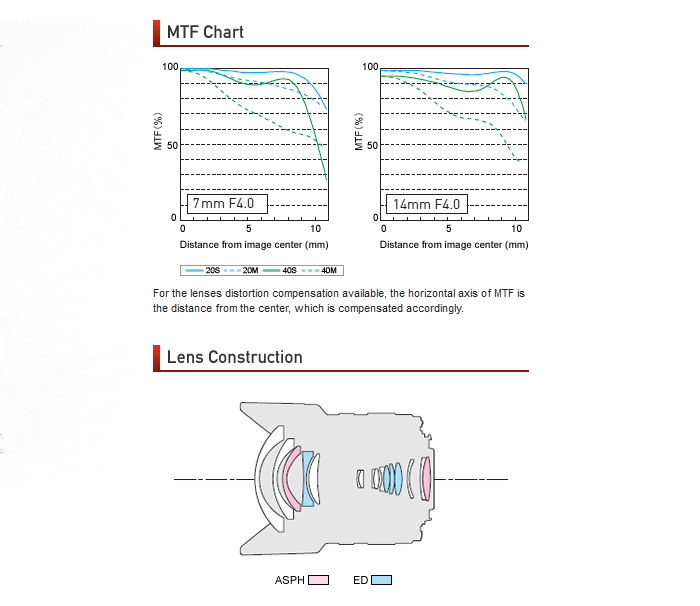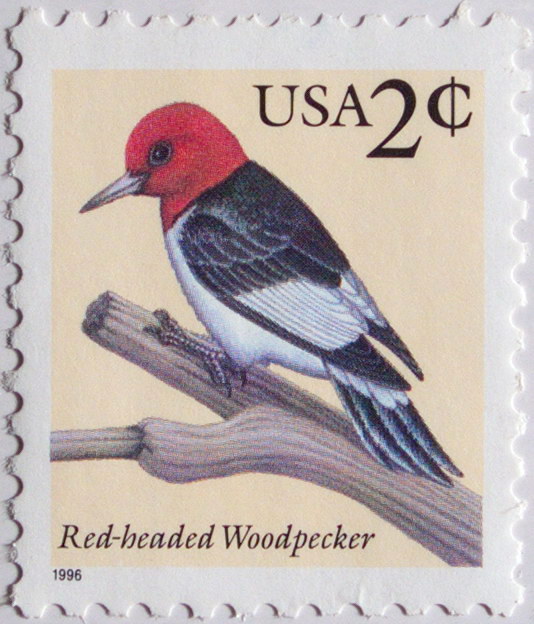|
Full review of the Panasonic Lumix G Vario 7-14mm F/4 ASPH
The Olympus E-M5 was used for this review.
For a better understanding of terms and methods used in this review, go here.
The usual center, mid-section and corner crops are located at the very bottom of the page.
Introduction.
The Panasonic Lumix G Vario 7-14mm F/4 (Made in Japan) is a very compact and light-weight ultra wide angle zoom lens specifically designed for Micro four thirds cameras. Don’t confuse this lens with the one from Olympus with the same zoom length. The specs say there are four ‘ED’ elements used in its construction, plus a couple of aspheric elements, which is displayed by the abbreviated “ASPH.” on the lens hood and box. There is no optical image stabilization, but that’s not super important on an ultra wide lens.
Fit and finish are quite good. The lens is clad in high quality plastic, with a built-in plastic petal style hood, (sorry, no filter use on either end, but see next paragraph). Focus and zoom rings have a ribbed design, but the focus ring is not rubberized for some reason, probably because they don’t expect you to use it.
You can successfully use a 77mm filter or larger by holding it up to, and touching the lens hood. This method works through 10mm to 14mm. Below 10mm you’ll see the filter cut the corners off the image. You can use 9mm if you plan on adjusting for distortion.
The zoom action is smooth and damped properly in my opinion, (one finger zooming is possible) and holds its position well, so there is no zoom creep during normal use; which is good as there is no zoom lock. Although there is no external zoom extension, the bulbous front element extends (rises) within the hood about 5mm as you zoom from 14mm to 7mm. Due to this design, I wouldn’t recommend using it in rain or high splash areas. Focal length index marks come at 7mm, 8mm, 9mm, 10mm, 12mm, and 14mm. The EXIF date matches those lengths.
In the box: the lens in bubble wrap, front and rear caps, a nylon carrying bag and owner’s manual. The front cap is a slip-on type; be careful when installing it as it fits tightly and will probably scratch the lens hood over time.
Focusing. This lens auto-focuses almost silently. Focusing seems quite accurate at all focal lengths, and reasonably quick in good light, but it struggles in low light.
Requisite product shots.
General information and specifications.
Optical qualities summary.
Lens flare/ghosting. Some small to medium magenta colored blobs appear when super bright light sources are close to, or inside the frame, samples below.
Color fringing (CA). Very good control at the long end, average control at the short end. You’ll see some magenta and cyan at high contrast edges along the sides of the image.
Bokeh. A little ‘busy’ at all focal lengths, but getting any background blur is tough at these super short focal lengths.
Color. Neutral.
Close up filter. N/A.
Coma. None that matters.
Regular filters: N/A
Filter size:. Filters are not supported due to the built-in hood.
Distortion. very low when shooting jpegs. RAW shooters will see heavy barrel distortion at 7-10mm, but it corrects pretty well in post. Check out the cropped samples below.
Barrel distortion is very strong in uncorrected images like RAW at 7mm through 10mm, however, as you zoom out, pincushion distortion is minor at 12mm to 14mm. There doesn’t seem to be any in-camera distortion correction going on at 14mm. Just for clarity, the ‘corrected’ version is what comes out of the camera when saving images as jpegs. The RAW distortion at 7mm is correctable in most image editing programs because of the relatively simple curve.
Light fall-off.
Light fall-off is moderate at all focal lengths at F/4. Stopping down to F/5.6 significantly brightens the sides of the image, and a little more so at F/8 (not shown). Oddly, uncorrected files show almost the same signature as the corrected files. Flare and ghosting.
The Panasonic 7-14mm lens produces average, to above average amounts of ghosting at all focal lengths, with magenta blobs being most prominent when the sun is close to, or inside the frame. Contrast is good at all focal lengths, even when the sun is inside the image. Bokeh samples.
Bokeh looks a little ‘busy’ at all focal lengths no matter what the aperture. I see outlines around the disks, especially noticeable at large viewing sizes, although 14mm at F/5.6 is not bad. Background blur is hard to obtain with such short focal lengths; here I focused on something just a foot or so (.3m) away to get this kind of blur at 15′ (5m). Bokeh is the character of out of focus highlights, and not simply how far out of focus the background is.
Let’s check out the close focus capabilities of this lens. Check out the 100% cropped portion of the full image. The sample shot was taken with the Olympus E-5M 16mp camera, so don’t compare it to others that were taken with 12 or 24mp cameras. The subject is a standard US stamp, 0.87″x 1.0″ or 22mm x 25mm. Also, note the shot was taken as close to the subject as focusing allowed; in this case a very short 4.85″ (123mm), measured from the front of the lens barrel to the subject.
This lens has a small reproduction size of 0.08x, (0.15x or 1:6.6) in 135 film format, and it produced a sharp, but small close focus shot at F/7.1. As a side note; the “1996” on the bottom left of the stamp measures a mere 1mm wide.
Conclusion.
The Panasonic Lumix G Vario 7-14mm F/4 is an ultra wide zoom lens with the same coverage as a full frame 14-28mm lens, however, being that it’s a micro 4/3 lens, it’s much smaller, lighter, and a little less expensive (but still pricey) than a full frame lens. Overall, the Panasonic turned in a great review, so let’s look at the many pluses, along with a negative or two.
Resolution wise, the lens is excellent at F/4 throughout the zoom range, there is no need to stop down for extra sharpness, however, depth of field is another issue.
Color fringing is not problematic once you leave the ultra wide end, and even so, it’s correctable in most image editing software if you shoot in RAW. Ghosting control is average with several small magenta blobs and arcs showing up in super bright light, and seems to be about the same at all focal lengths. Flare control is above average, with the contrast holding up well at all focal lengths even with the sun inside the image.
Distortion is not an issue at all when shooting in jpegs, but 7mm-9mm barrel distortion is strong when saving as RAW, but again, it’s a relatively easy fix in post as the distortion curve is relatively simple.
Close focus quality is very good , but the reproduction size is small.
The only disappointment is the lack of a filter thread; but as I pointed out in the introduction, you can use a 77mm or larger filter at all but the widest settings like 7-8mm.
The current price is almost a grand, making it much more expensive than the Olympus 9-18mm which does accept filters. At the time of this review I haven’t been able to compare the two, but I doubt it will perform as well as the 7-14mm.
Highly recommended for Landscape, interiors, and Real Estate photography.
|
|
Sample crops from the centers, mid-sections and corners.
7mm.
10mm.
14mm.
It’s almost boring to discus the sharpness of this lens; the crops are boring too, but that’s another story. The centers are very sharp at F/4 throughout the zoom range, with the sides coming very close to the centers in resolution; this is partly due to the distortion, which makes things larger as you near the sides. Other than a brighter image due to less light fall-off, the F/5.6 crops look about the same as F/4. As you stop down to F/8, diffraction is noticeable, and the image becomes quite soft at F/11 and smaller.
All focusing distances were at or near infinity using manual focus and focus bracketing. Exposure differences are due to light fall-off.
That’s it for the review, if you’d like to help out the site, please visit B&H Photo if you’re thinking of purchasing the Panasonic 7-14mm F/4 micro 4/3 lens. |


